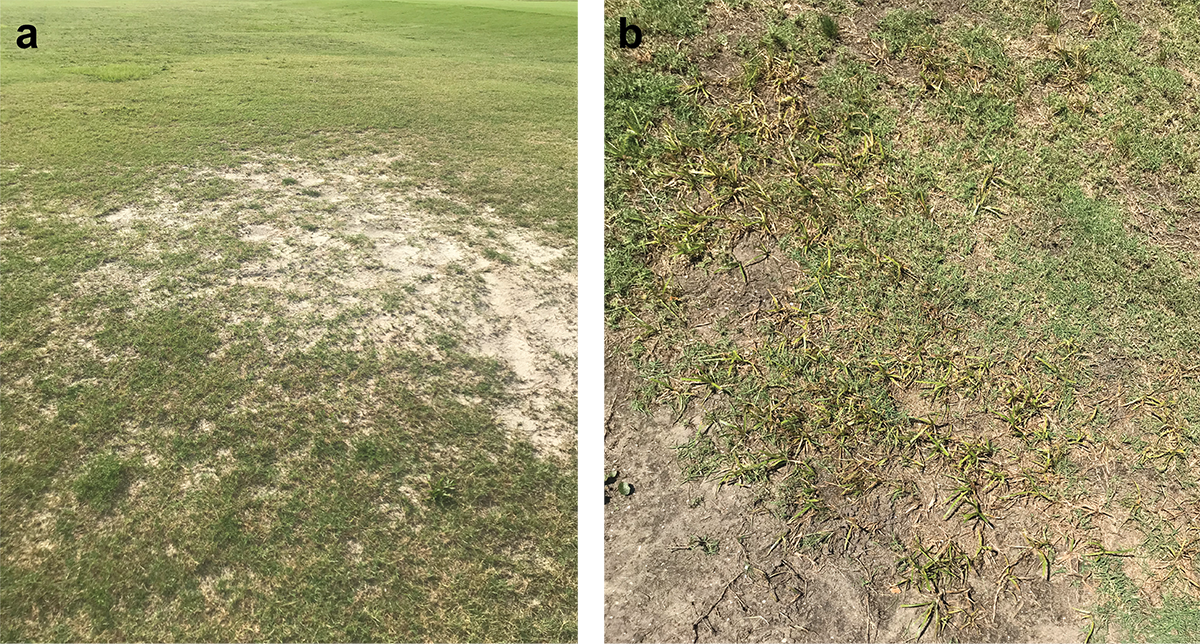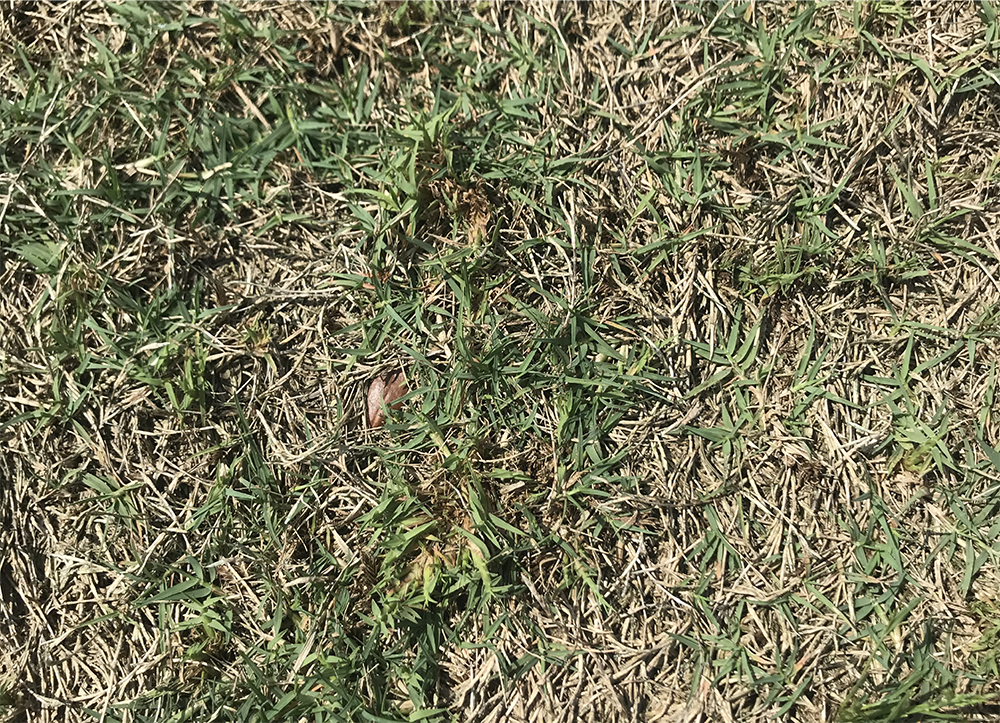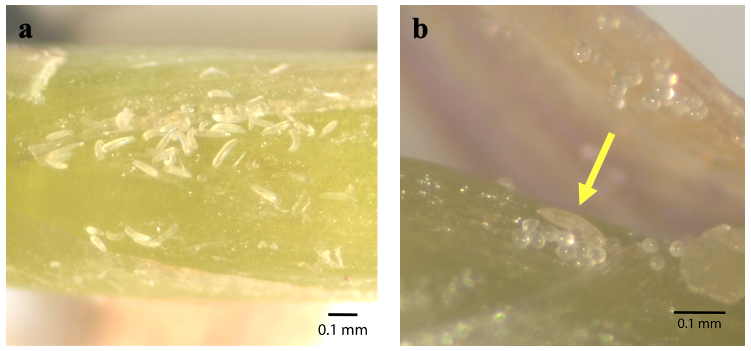This publication describes bermudagrass mite biology, identification, and available control options in turfgrass. Golf course superintendents, sports field managers, sod farmers, other turfgrass and landscape professionals, and hay producers will be able to accurately diagnose the pest problem and use the presented biology and management information to develop an effective management program.
Introduction
Bermudagrass mite (Aceria cynodoniensis; a.k.a. bermudagrass stunt mite and couch grass mite) is a challenging pest to manage in bermudagrass turf and hay.1,2 Bermudagrass mite is an introduced pest first reported in the United States in 1959 that has spread from Arizona through the southern United States.1 Challenges with managing bermudagrass mite stem from (1) inadequate methods to identify and confirm mite infestation, (2) lack of effective management tools, and (3) difficulty in reaching mites sheltered between leaf sheaths and stems with miticides.
Host and Damage
Bermudagrass mite attacks only bermudagrass and appears equally damaging on common and hybrid turf cultivars and hay cultivars.3 Mite infestation causes shortened internodes, stunted leaves, swollen stems, and tiller proliferation from the infested nodes (figure 1). These symptoms are called “witches’ brooms,” which the distorted and bunched shoots resemble. Symptoms of bermudagrass mite infestation can appear as early as thirteen days after infestation.4 Figure 1 shows symptoms of mite infestation on common bermudagrass (figure 1a), Celebration bermudagrass (figure 1b), and the hybrid bermudagrass cultivars Tifgreen (figure 1c) and Tifway (figure 1d).

Figure 1. A bermudagrass mite-infested shoot (left) and an uninfested shoot (right) (1a). Witches’ broom symptoms on bermudagrass cultivars Celebration (1b), Tifgreen (1c), and Tifway (1d). Yellow circles highlight the symptomatic shoots. Image credit: Matthew Brown, Clemson University.
Mite infestations reduce stolon and root development, resulting in thinned and eventually dead turf. Heavy infestations cause large bare spots in turf, which ruins turf aesthetics and playing surface and allows weeds to invade easily (figure 2). Infestation also greatly reduces hay yield. On sod farms, mite infestations reduce growth and ruin sod quality.

Figure 2. Turf with a heavy bermudagrass mite infestation (a). Mite-infested turf often has bare spots due to reduced stolon and root development or turf death resulting from mite infestation (b). Image credit: Matthew Brown, Clemson University.
Dense knots of witches’ brooms and thinned turf impair playability on golf courses and athletic fields (figure 3). Besides direct mite damage, mite-infested turf often suffers from other pests, such as bermudagrass scale (Odonaspis ruthae), rhodesgrass mealybug (Antonina graminis), nematodes, and helminthosporium leaf spot (caused by fungi of the genera Bipolaris, Drechslera, and Exserohilum).3,4

Figure 3. Knots of mite-infested shoots and thinned turf can impair the playability of the turf surface. Image credit: Matthew Brown, Clemson University.
Peak occurrence of mite damage appears to vary from year to year. Symptomatic shoots are generally more noticeable during late spring and summer, with peak abundance occurring in June.5 Observations in South Carolina generally agree with this broad trend. However, in 2020, the greatest abundance occurred in April, which was earlier than usual and indicated that the occurrence of mite-infested shoots might change from year to year. In the same year, golf course superintendents reported observing the greatest mite damage during March and October in Florida (A. Dale, personal communication; unreferenced). The severity of mite infestations varies with locale, being most problematic in warmer, coastal regions, while colder areas can experience problems during seasons after mild winters. Golf courses need to scout regularly for the appearance of witches’ brooms each spring to accurately identify bermudagrass mite early enough so that early control may limit the buildup of severe infestations and damage to turf.
Biology and Life Cycle
Bermudagrass mite is similar in appearance to other members of the family Eriophyidae, which are elongated, white, tiny, and have only two pairs of legs (figure 4). Mites are visible only with a hand lens or microscope with at least fifteen times magnification. Eggs are between 0.0008 and 0.002 inches long. Larvae are ~0.002 inches. Nymphs are ~0.005 inches, and adults are ~0.008 inches.6 A mite develops from egg to adult in seven to ten days.6 A few to thousands of individuals of all life stages live underneath the leaf sheaths and feed on the stems. Bermudagrass mites spread to uninfested grass by wind and likely also by crawling.4 Transport of infested sod or clippings spreads mites over long distances.4

Figure 4. Bermudagrass mite colony on bermudagrass stem (a). Bermudagrass mite with eggs on stem and underside of the leaf sheath (b). The arrow points to an adult bermudagrass mite in the background. Image credit: Matthew Brown, Clemson University.
Monitoring
Some symptoms attributed to bermudagrass mite infestation, such as stunted shoots and discolored or thinned turf can also be caused by drought, nematodes, root diseases, or other factors.4 As a result, observing these symptoms is not the best approach to diagnose a bermudagrass mite infestation. Visual symptoms, such as witches’ broom appearance (figure 1), may serve as indicators of areas to monitor. Reserve verification of mite infestation only until careful examination reveals the presence of mites. Since witches’ broom symptoms remain even after mites are killed, confirming mite presence is essential in assessing treatment efficacy.4 Remove the leaf sheaths of a witches’ broom first and then observe the exposed stems for the presence of mites and eggs using a hand lens with at least fifteen times magnification or a microscope (figure 4).
Management
Cultural Control
Bermudagrass mite infestations are often associated with stressed turf, especially drought-stressed turf.1,3 Irrigation reduces the number of mite-infested shoots (M. Brown, unpublished data, 2020), likely by alleviating drought stress. Lowering mowing height or scalping (mowing to remove all aboveground green tissue) reduces the number of mite-infested shoots (M. Brown, unpublished data, 2020), explaining why bermudagrass mite is rarely a problem on short-mown turf, such as golf course greens.4 Scalping may serve as a management approach by removing bermudagrass mites; but clippings must be collected and discarded to avoid dropping the clippings and possibly spreading the mites.7 Miticide applications to the turf after scalping further reduce the number of witches’ brooms compared to scalping alone (M. Brown, unpublished data, 2020). Higher nitrogen fertilization rates worsen bermudagrass mite infestations (M. Brown, unpublished data, 2020). In infested areas, avoiding fertilizer application beyond that necessary for maintaining turf health may help limit the progression of infestations. Fertilizer recommendations for bermudagrass turf in South Carolina are provided in the Bermudagrass Yearly Maintenance Program factsheet on Clemson Extension’s Home & Garden Information Center website, hgic.clemson.edu. Turf managers outside of South Carolina should contact their local extension for fertilizer rate recommendations. Cultural control practices are particularly valuable in turf systems where effective miticides are not available (i.e., turf that is not on golf course greens, tees, or fairways).
Host Resistance
Bermudagrass cultivars show varying levels of susceptibility to bermudagrass mite damage.3 Bermudagrass cultivars used on sports fields and golf course fairways and roughs vary from moderately resistant (Midlawn, Tifsport, and GN-1) to moderately susceptible (Patriot and Celebration). Ultradwarf cultivars used on golf course greens (MS Supreme, Tifeagle, Floradwarf, Champion, MiniVerde, and Tifdwarf) are rarely infested with mites when maintained at their typically short height. However, ultradwarf cultivars are highly susceptible when they are maintained at a taller mowing height.4,8 Some cultivars, such as Tifway and Tifgreen, show resistance in some studies but susceptibility in others.4,8,9 There is no common or hybrid bermudagrass cultivar that has demonstrated consistent resistance against the bermudagrass mite.3,4,8,9
Chemical Control
Miticides are commonly used to manage bermudagrass mite infestations but provide inconsistent control. Because of the high population densities of bermudagrass mites, they can re-infest a treated area quickly, resulting in a higher cost due to repeated (sometimes weekly) chemical applications. Carbamates (aldicarb, carbanolate, oxamyl, and propoxur) and organophosphates (carbophenothion and diazinon) were initially identified as chemicals effective against bermudagrass mites.10 However, these chemicals are no longer available for use on turfgrass. Pyrethroids (bifenthrin, cyfluthrin, deltamethin, lambda-cyhalothrin, and permethrin) were ineffective against the bermudagrass mite in trials conducted in South Carolina and elsewhere.11 Abamectin (pesticide trade names are Divanem and Todal) is effective against bermudagrass mites and can be used on golf course greens, tees, and fairways.7,11 A second application of abamectin plus surfactant is necessary within two weeks to control mites hatched from eggs after the initial application.7 The addition of a penetrating non-ionic surfactant increases miticide efficacy by improving coverage of miticide solution under the leaf sheaths where the mites are hidden (J. Chong, unpublished data, 2020).
Note that the severity of mite infestations can rise and drop quickly, even without management. So, after using control strategies, monitor the infested area for symptomatic shoots to evaluate the need for additional control and limit unnecessary chemical applications. Even if control is successful, symptomatic shoots will still be present in the infested area, though the shoots will usually be dead. If infestations persist, additional biweekly applications throughout the growing season may be necessary to maintain high-quality and less-infested turf. Since damaged turf must recover from the injuries caused by mites, fertilizer applications may be necessary to improve turf regrowth after control strategies have reduced or eliminated mite populations. A soil test can indicate the need for fertilizer application. Foliar applications of nitrogen may achieve better results since the root system is likely damaged.
References Cited
- Tuttle DM, Butler Jr GD. A new eriophyid mite infesting Bermuda grass. Journal of Economic Entomology. 1961 Oct;54(5):834–838.
- Sprenkel RK, Buss EA. Insect management in pasture. Gainesville (FL): University of Florida, Institute of Food and Agriculture Sciences Extension; 2011 Feb. ENY-402. https://ipm.ifas.ufl.edu/pdfs/Insect_Management_In_Pasture_IG06100.pdf.
- Reinert JA, Taliaferro CM, McAfee JA. Susceptibility of bermudagrass (Cynodon) varieties to bermudagrass mite (Eriophyes cynodoniensis). Acta Horticulturae. 2008 Jun;783:519–528.
- Johnson DJ. The bermudagrass mite Eriophyes cynodoniensis (Sayed) (Acari: Eriophyidae) in Florida with reference to its injury symptomology, ecology, and integrated control [dissertation]. Gainesville (FL): University of Florida; 1975.
- Hudson WT, Reinert JA. Eriophyid mite pests (bermudagrass, zoysiagrass, buffalograss, grain rust, and St. Augustinegrass). In: Brandenberg RL, editor. Handbook of turfgrass insects. 2nd ed. Lanham, MD: Entomological Society of America; 2012. p 30–33.
- Butler Jr GD. The biology of the bermudagrass eriophyid mite. Arizona Agricultural Experiment Station Turfgrass Research Report. 1964;219:8–13.
- Boeri PA, Benda ND, Unruh JB, Dale A. Biology and management of the bermudagrass mite, Eriophyes cynodoniensis. Gainesville (FL): University of Florida, Institute of Food and Agriculture Sciences Extension; 2018 Jul. ENY-342. https://edis.ifas.ufl.edu/in1217.
- Loch DS, Seeman OD. Incidence and distribution of mite species across a reference collection of Cynodon spp. (bermudagrass) genotypes growing in subtropical Australia. International Turfgrass Society Research Journal. 2017 Nov;13(1):512–516.
- Butler Jr GD, Kneebone WR. Variations in response of bermudagrass varieties to bermudagrass mite infestations with and without chemical control. Arizona Agricultural Experiment Station Turfgrass Research Report. 1966;230:7–10.
- Reinert JA. The bermudagrass stunt mite. USGA Green Section Record. 1982 Nov;20(6):9–12.
- Chong JH, Brown M. Bermudagrass mite: searching for management solutions. Golf Course Magazine. 2018 Dec. https://www.gcmonline.com/course/environment/news/bermudagrass-mite.

